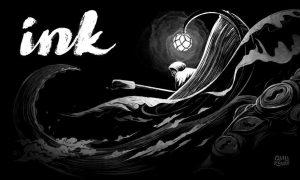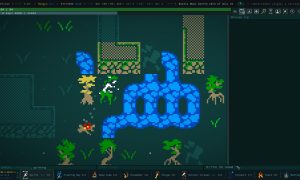 Japanese role-playing game experiences can often be bittersweet. Even the greatest JRPG titles sometimes have terrible storylines amidst great gameplay, or vice versa. Very few titles in the genre can rise to the ranks of all-time greatness, though even those with severe “bad” qualities still typically have redeeming value, particularly for rabid fans of the genre. But some sink to the depths of pure bitter worthlessness, a place reserved for games with horrid characters, juvenile storytelling, putrid dialogue, and an overall sense of “screw it, they’ll buy it anyway.” Time and Eternity, the newest RPG from NIS America, blasts through that veil of terribleness, past all others, into a new world of bottom-of-the-barrel gaming experiences.
Japanese role-playing game experiences can often be bittersweet. Even the greatest JRPG titles sometimes have terrible storylines amidst great gameplay, or vice versa. Very few titles in the genre can rise to the ranks of all-time greatness, though even those with severe “bad” qualities still typically have redeeming value, particularly for rabid fans of the genre. But some sink to the depths of pure bitter worthlessness, a place reserved for games with horrid characters, juvenile storytelling, putrid dialogue, and an overall sense of “screw it, they’ll buy it anyway.” Time and Eternity, the newest RPG from NIS America, blasts through that veil of terribleness, past all others, into a new world of bottom-of-the-barrel gaming experiences.
[singlepic id=14142 w=320 h=240 float=left]Time and Eternity is the story of a young princess named Toki, who through her royal lineage has the power to travel through time. Inside of her is another soul, named Towa, who is identical aside from a crop of blonde hair in the place of Toki’s flowing red locks. Toki and a young knight (who you get to name, but we’ll call by his default name, “Zack”) are to be wed soon. However, Toki has been told by a psychic named Makimona that her wedding will be attacked. After a tea party with her fiance and friends she is convinced the prediction is nonsense. Unfortunately, the next day at the wedding, Makimona proves to be correct, as the wedding is attacked and Zack is mortally wounded. Toki transforms into Towa, who is a tougher, more “badass” version of Toki, and vanquishes the assassins. In a last ditch effort to save Zack and her wedding, Toki/Towa uses her time magic to go back in time six months, to the date of Makimona’s premonition. Her time travel has accidentally trapped Zack’s soul in the body of Toki’s pet dragon, Drake. After finding the psychic and learning that her vision was a guess, Toki and Drake set off to find the assassins and save their wedding from disaster. What ensues is a non-stop snore fest through the past, which leads to an infinite loop of the same situation over and over again.
[singlepic id=14143 w=320 h=240 float=right]The story of Time and Eternity has some potential, but the payoff falls flat on it’s face. The concept of time being folded onto itself, and the events of the past affecting the events of the future is always fun, but in the hands of this game’s writers comes out as simply “walk to place A, talk, go back to home, talk more, and then go to place B and talk.” The story goes from an exciting time-travel romp to deliver justice and empower love, to a slow-trudge through conversations about fairies and comments about how great it would be to see some boobies. The characters are purely archetypal who never approach well-roundedness. They instead insist on the one point about themselves that matters to the game. Toki is an eager-to-please housewife, and that’s it. Zack is a sex-starved pubescent mess, and that’s it. Toki’s friends are vapid, singularly focused cliches, and that’s it. The game makes an effort to drive home a handful of jokes and scenarios, replaying them over and over again for the same effect. When a overly-romantic male named Ricardo attempts to win Toki’s heart, Zack, inside the body of Drake, chomps down on his head with his powerful dragon jaws. While it may elicit a chuckle the first time it happens, by the 15th time, it becomes a drag on an already dragging story. That’s just one example of about 6 or 7 jokes and personalities that are rehashed infinitely throughout the story.
[singlepic id=14144 w=320 h=240 float=left]The graphics are previous generation at best, as everything is hand-drawn and thus is 2D. The models look nice enough, but unfortunately for the artists, the 2D models in this day and age just don’t retain charm and it looks rather lazy instead of kitschy and cute. This observation is reinforced with the absolute lack of inspiration in the locations themselves. Every single location has the same design and basic layout. While cemeteries have headstones, and valleys have old columns or something to that effect, nothing significant differentiates one locale from another. One location, a canyon, has you enter in one direction, and then the very next location is just the same map, reversed, with one section removed. Every single task is the same. You get a mission from a character, and then go to a location like “Panela Isle” or “Southern Canyon” and go from one side to the other, fighting random enemies. People and items of interest are shown as spade or heart shaped markers on the overmap, and only appear in cutscenes when activated. In effect, while on the map, you are alone. When you find a marker, you’ll click it, triggering a small cutscene. About 80% of the tasks are simply “this guy wants something, go clear across a map to give it to him, and then come back for another tea party” and it’s made more “challenging” by placing objectives as far away from the starting position as possible. This is so cheap that I can’t even place fair terms on it.
[singlepic id=14145 w=320 h=240 float=right]During those jaunts across flat, uninspired landscapes you’ll run into a number of monsters. That number is about 8, as in, there is really is only about 8 or so different enemy models in the entire game. You’ll fight a dirt golem, a flying stingray, a big overweight bird, a ghost, and some assassins, all of which will continually show up down the road as stronger “new” enemies with alternate colorways. Sometimes a boss battle can break that monotony, but then afterwards, you’ll start fighting alternate colorways of those bosses as regular enemies. The battles themselves are, by far, the most monotonous events in this entire game. With the lack of a party (your battle party is simple Toki or Towa, whichever form is in the game currently, and Drake who you can’t control.) it’s designed to be one-on-one battles, with enemies waiting patiently for their turn to fight. A little counter in the bottom right corner tells you how many fights you have left in one battle. It’s a strange concept, but not an entirely bad one. The problem is the fighting itself. Battles are set up with you and the enemy at ranged weapon distance. The enemy can come into your space for melee combat, or you can go to him. Each monster has different attacks based on their distance from you.
[singlepic id=14146 w=320 h=240 float=left]To fight, you press the attack button, over and over again. That’s basically it. You just mash on it until the thing in front of you is dead. You can also dodge attacks by pressing left, right, or up on the left stick. This would be fun except all attacks are announced at the bottom of the screen and many have a timer that tell you basically when to jump. The only time you get hit is when you attack too late and the animation sticks, holding you in place for the oncoming blast or high kick. Later in the game, you start to receive special attacks like spells or flurry attacks, which can lead to some strategy, but mostly it’s dodge an announced attack, mash a button, dodge again, and then press the triangle button instead of the circle button. At first, the battles were too easy, as I never even came close to dying and all of my healing items healed me entirely, no matter what level my HP was at. Toki/Towa can be made dizzy, a debuff that disallows you from moving or attacking for a short time, by taking too many hits in one battle. Though this is designed to be a threat from the beginning, I didn’t have it triggered on me until about 30 hours into gameplay. But later in the game, due to poor level balancing, the enemies became intensely hard to beat. Their attacks hadn’t changed, the damage they did hardly went up, they just are simply given ridiculously high HP totals that your character simply cannot deplete without eventually dying, mostly in my experience to mental fatigue of having mashed the same button for 45 minutes.
While most battles at later stages of the game won’t take quite that long, they are still very, very long battles that reward the player with scant experience and require multiple hours of play just to gain a level or two. Toki and Towa never get all that more powerful as they level (I started level 1 doing around 60 damage and stopped at level 20 doing around 130 damage, enemies at the time had upwards of 30,000 HP) so to be powerful enough to finish these battles is to subject yourself to video game torture. There is a time magic function that lets you play with the flow of time that you learn towards the middle parts of the game, but it’s basically useless and as such there is little to say about it. It’s only function as far as I can tell is to allow you stretch a 45 minute battle you hate fighting into an hour long battle you hate fighting.
[singlepic id=14147 w=320 h=240 float=right]All combined, we have a game that has a terrible story filled with poorly written and repetitive dialogue, a battle system that is confusing at best and simply not fun at it’s worst, a world in which everyone looks the same, enemy or not, quests that provide little interesting work beside “my friend needs a sandwich, deliver it to him”, and a graphical look that is dated and uninspired. There is little that redeems this game in it’s current state. A few things in this game could become good ideas in other games, however. One in particular is the dual-soul idea behind Toki and Towa. Both characters have different emphases in battle, alternate personalities for cut-scenes, and can learn different types of skills and spells. Another idea that is worth noticing is the one-on-one battle system. While it seems highly out of place when fighting wild monsters, imagine an RPG where everyone is a gentleman and fights duel style, no matter what? On second thought, maybe that wouldn’t work well in any game.
Lastly, this game is horrible for the mind of the humans who are playing it. The whole story is so sexist and anti-woman that it almost feels like Pat Robertson developed it. Every woman in the story is a weak-willed automoton who exists to be saved or to be chastised for being so stupid and useless on her own. Likewise, males in the game are shown as sex-driven ignoramuses, who are somehow able to live normal, upstanding lives while being completely inept and jokingly useless. This game appears to be designed for teenage girls, yet is rife with partial nudity and sexually suggestive poses more suited for adult males. In the end, even with a heroine who fights her way to ultimate victory, that victory is to simply be a housewife for the most petulant human being in the entire world.
This game is pathetic, and a real disappointment coming from the usually solid team at NIS America. It’s beyond unplayable. It’s offensive that something so poor could potentially cost unwitting gamers $60 that they could spend on, really anything, $60 dollars worth of toilet paper (more fun) or maybe $60 to a kid to beat the crap out of you (less humiliating.) While this game isn’t broken like a Superman 64 or a Daikatana, it is on their rare level of absolute worthlessness as a gaming experience. I implore you to avoid this game at all costs, and play just about anything else on the market with the joy in your heart that you aren’t playing Time and Eternity.
Patrick Rost has been with Gaming Trend since 2013. At first focused on sports coverage, Patrick has gone on to cover a wide range of games and other products for the website. Outside of Gaming Trend, Patrick writes and records music, grinds perpetually in Elder Scrolls Online (PS4), and lives day to day with his two dogs, Bob and Stella.

See below for our list of partners and affiliates:

























